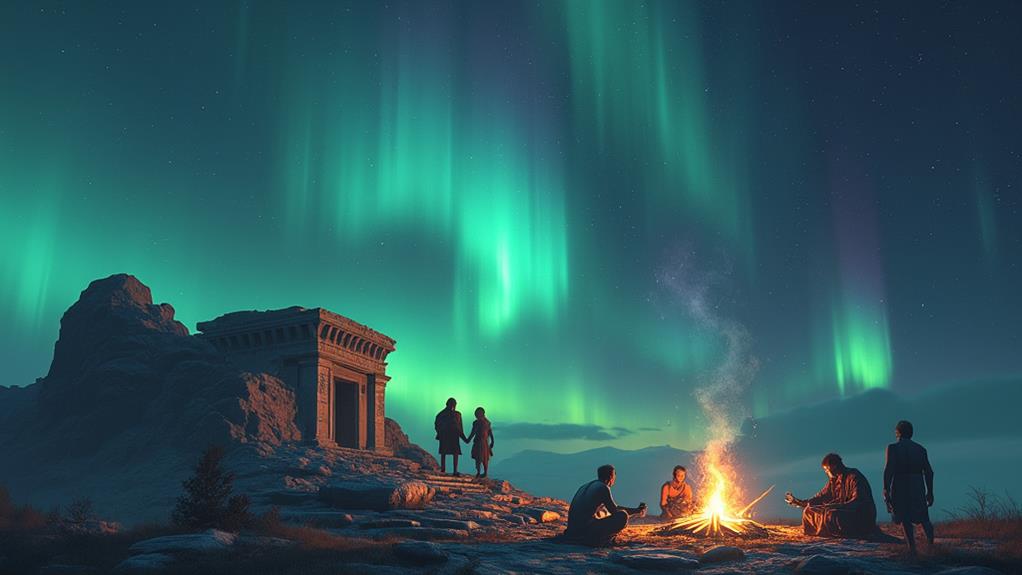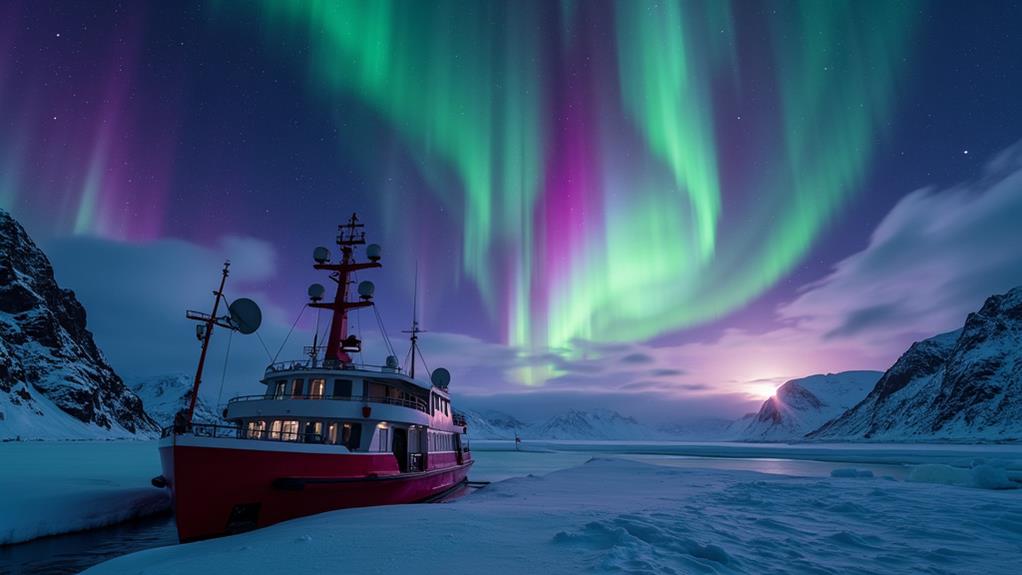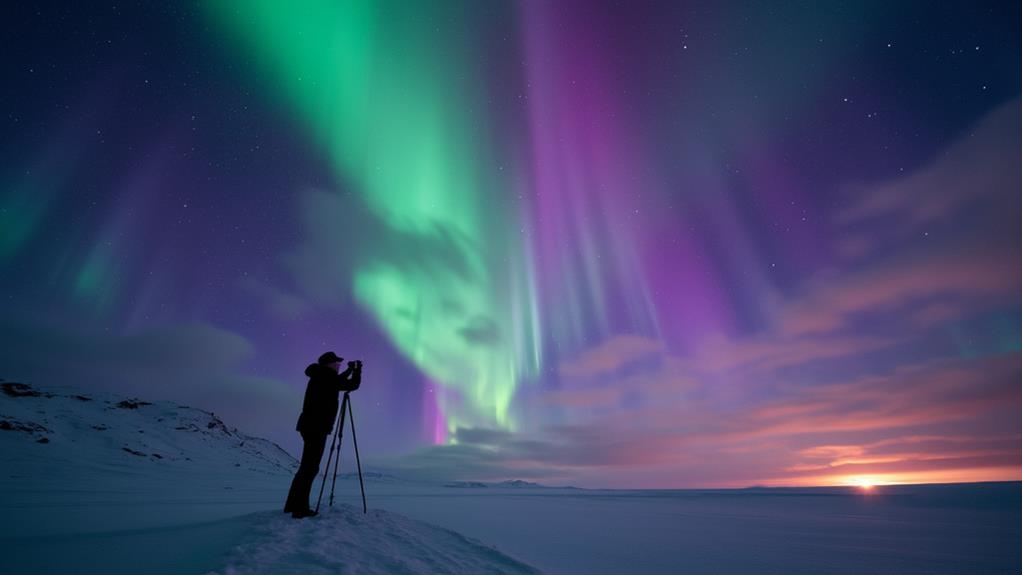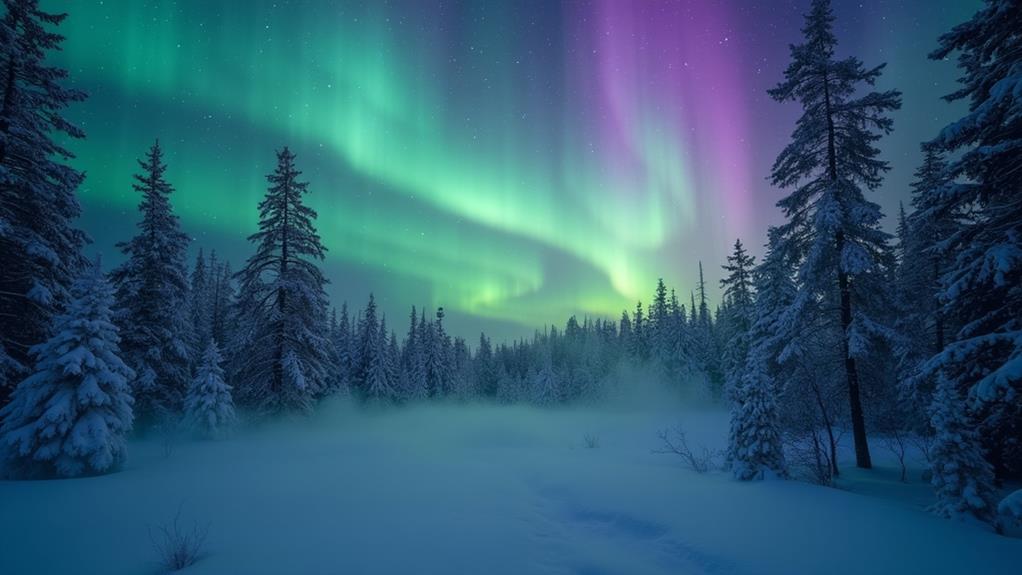Why the Northern Lights Are More Common in the Winter
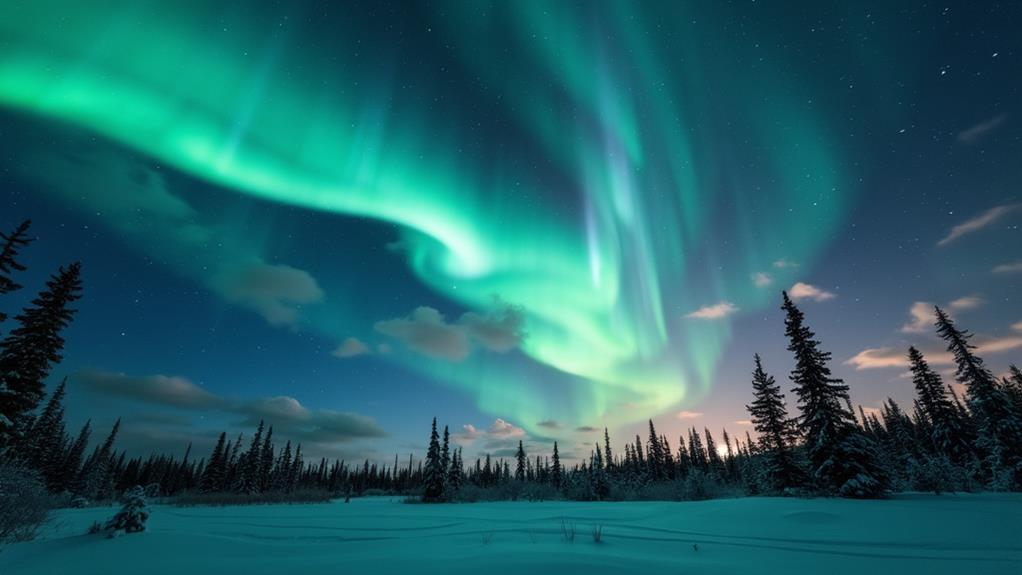
You might wonder why the Northern Lights seem to favor the winter months. It's not just a coincidence; several factors align to make this season particularly special for aurora enthusiasts. The extended darkness of Arctic nights provides a perfect backdrop, while the clearer, less humid air improves visibility. There's also increased solar activity that plays a significant role. Moreover, the winter season adds a distinct, magical quality to the experience, making it unforgettable. Want to know more about these enchanting lights and the best ways to witness them?
Longer Winter Nights
During the Arctic winter, nights can extend up to 24 hours of darkness, creating a prime opportunity to witness the breathtaking Northern Lights. From late September to late March, longer winter nights provide ideal conditions for aurora viewing, with peak times for sightings between 5 p.m. and 2 a.m.
Venturing into the Arctic's cold temperatures offers more than just a chill. These frigid conditions often lead to more stable atmospheric conditions, enhancing the visibility of the Northern Lights. The dark, uninterrupted winter nights form a perfect canvas for the lively auroras to paint the sky.
If you're planning a trip to see the Northern Lights, winter is the best time to go. The prolonged darkness and cold temperatures optimize your chances of a clear, bright display. So bundle up, head north, and let the longer winter nights reveal one of nature's most stunning spectacles right before your eyes.
Clearer Winter Skies
Clear winter skies are crucial for optimal Northern Lights viewing. The reduced moisture in the air results in fewer clouds and unobstructed views, especially from November to March when the atmosphere is drier. This dryness leads to clearer nights, which are essential for aurora hunting. These conditions significantly enhance the chances of witnessing the mesmerizing auroral displays.
The atmospheric clarity brought by cold temperatures during winter makes this period even more special for Northern Lights enthusiasts. Clearer skies allow for a more vivid and uninterrupted view of the lights, making the experience more rewarding. The sharpness and brightness of the auroras are at their peak during these conditions.
Key points to remember:
- Reduced Moisture: Winter air has less moisture, leading to clearer skies.
- Extended Viewing Hours: Longer nights in winter provide more opportunities for sightings.
- Peak Activity Times: The best time to see the Northern Lights is usually between 9 p.m. and 3 a.m.
Cold Weather Benefits
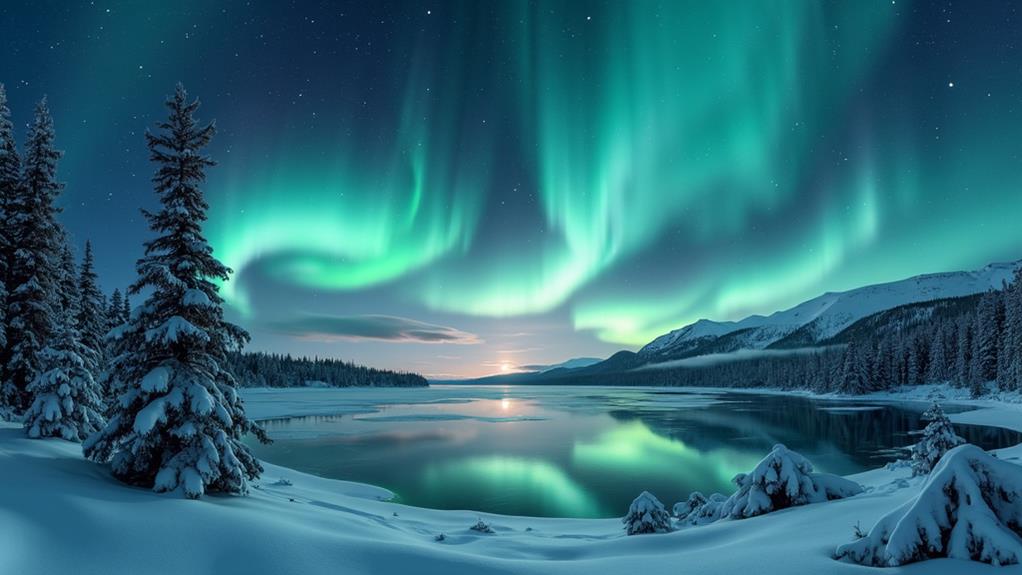
For Northern Lights enthusiasts, cold weather offers several distinct advantages. Lower temperatures, typical during winter months, slow down particle movement in the upper atmosphere. This results in a greater buildup of auroral energy, leading to brighter and more vivid displays of the Northern Lights. When temperatures drop, particularly around -20°C, atmospheric clarity improves due to reduced light scattering, enhancing aurora visibility and making the viewing experience more rewarding.
Additionally, the long, dark nights from late September to late March provide extended opportunities to observe these spectacular displays. Winter's stable atmospheric conditions often minimize cloud cover, resulting in clearer skies that are ideal for aurora sightings. Historical data even suggests that colder weather events are associated with more frequent and intense auroras.
Here's a quick summary of the benefits of cold weather for aurora viewing:
| Benefit | Description | Impact on Auroras |
|---|---|---|
| Slower particle movement | Greater buildup of auroral energy | Brighter displays |
| Increased atmospheric clarity | Reduced light scattering | Improved visibility |
| Long, dark nights | Extended viewing opportunities | More chances to see auroras |
| Stable atmospheric conditions | Minimized cloud cover | Clearer skies |
Increased Solar Activity
As solar cycle 25 peaks between early 2024 and late 2025, you can expect more frequent and vibrant northern lights due to heightened geomagnetic activity. During this period, stronger auroral displays might even be visible at lower latitudes, making winter an ideal time for aurora sightings. Monitor the Kp Index to track these solar events and increase your chances of experiencing this awe-inspiring phenomenon.
Solar Cycle Peaks
Have you ever wondered why the Northern Lights seem more dynamic and frequent during certain times? The answer lies in the solar cycle, an approximately 11-year cycle that governs solar activity, including the frequency and intensity of solar flares. During the peak of this cycle, known as the solar maximum, the Sun releases more charged particles. These particles interact with Earth's magnetic field, resulting in more frequent and colorful auroras.
Key points to remember:
- Solar Cycle Peaks: The current solar cycle (Cycle 25) is expected to reach its peak between early 2024 and late 2025. This period, known as the solar maximum, will greatly enhance auroral activity.
- Increased Solar Activity: During the solar maximum, solar storms release an abundance of charged particles, enhancing the likelihood and intensity of auroras.
- Expanded Visibility: Historical data shows that heightened solar activity during solar maximums allows auroras to be observed further south than usual, broadening the geographical range where you can see these stunning displays.
Enhanced Geomagnetic Activity
During periods of increased solar activity, heightened solar wind and frequent solar flares bombard Earth's magnetic field with energetic charged particles, creating spectacular auroral displays. This phenomenon is driven by the solar cycle, which peaks approximately every 11 years. Currently, we are in solar cycle 25, expected to peak between early 2024 and late 2025, leading to more frequent and intense auroras.
Winter months, from late September to late March, are prime time for these displays. During this period, Earth's position relative to the Sun increases the likelihood of geomagnetic storms, which are a key factor in boosting the visibility of the Northern Lights. The Kp Index, which measures geomagnetic activity, often shows higher values during winter solar events, increasing the chances of seeing auroras at lower latitudes than usual.
Moreover, cold winter nights with clear skies provide ideal conditions for viewing. The atmospheric clarity during these nights enhances the visibility of the auroras, making them more vivid and awe-inspiring. Therefore, winter is the perfect season to witness these natural light shows, thanks to enhanced geomagnetic activity.
Stronger Auroral Displays
Winter months are ideal for witnessing stronger auroral displays due to increased solar activity. During the solar maximum phase of the 11-year solar cycle, the frequency and intensity of the northern lights significantly increase. We are currently in solar cycle 25, which is expected to peak between early 2024 and late 2025, coinciding with winter months. This period offers optimal conditions for viewing more vibrant and widespread auroras.
Heightened solar activity, such as during solar storms, results in more frequent collisions between charged particles from the sun and Earth's atmosphere. These collisions produce the stunning auroral displays that illuminate the sky. Winter's clear, cold nights enhance visibility, making it easier to observe these spectacular events.
To maximize your aurora-viewing experience:
- Stay updated on the Kp Index: This index measures geomagnetic activity, and higher values often indicate intense auroral events.
- Monitor solar activity forecasts: Predicting solar storms can help you plan your viewing.
- Choose locations with minimal light pollution: Darker skies enhance aurora sightings.
Peak Viewing Times
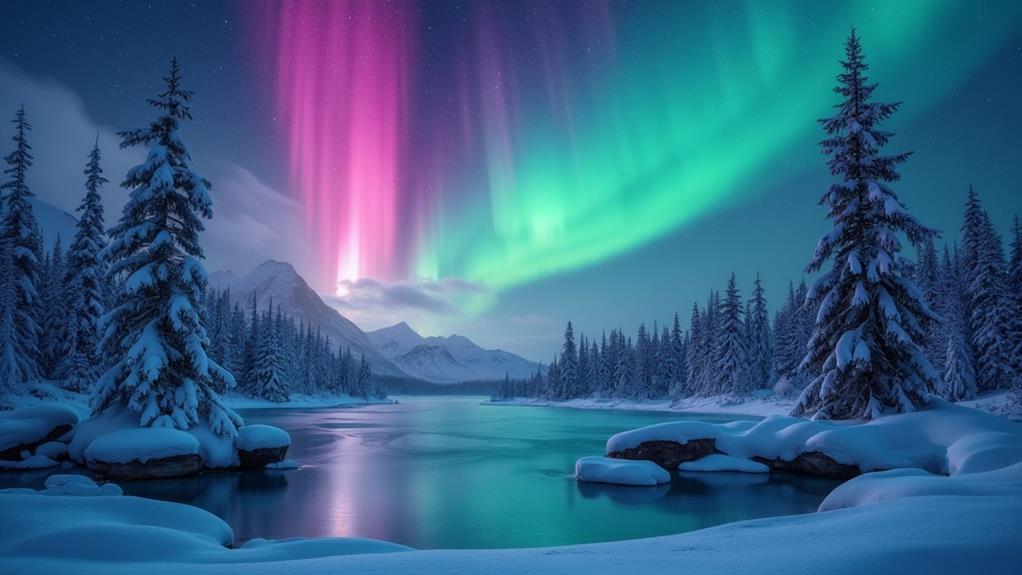
The optimal time to witness the mesmerizing Northern Lights is from late September to late March, with peak activity around the equinoxes in March and September. During these periods, auroral visibility is at its highest, offering the most spectacular displays. For prime viewing hours, plan to be outside between 6 p.m. and 1 a.m., although the most intense activity often occurs between 9 p.m. and 3 a.m.
In winter, the longer nights provide more opportunities to catch this stunning natural phenomenon. The colder temperatures, often plummeting to around -20°C, also contribute to heightened auroral activity. Clear, cold skies reduce atmospheric interference, allowing the Northern Lights to shine brightly.
Monitor the Kp Index, which measures geomagnetic activity. Higher readings on the Kp Index indicate increased solar storm activity, enhancing your chances of seeing the Northern Lights. Winter months generally see more of these geomagnetic disturbances, making it an excellent time for aurora hunters. So, bundle up, find a dark spot, and prepare to experience one of nature's most awe-inspiring shows.
Dark Sky Conditions
Winter's long, dark nights are ideal for catching the Northern Lights. The extended darkness from late September to late March reduces light pollution, making auroras more vivid and easier to see. Clear, dark skies not only improve visibility but also increase the chances of frequent and intense displays.
Reduced Light Pollution
Thanks to the longer nights and shorter days during winter months, light pollution is greatly reduced, offering clearer views of the Northern Lights. The winter season, particularly from late September to late March, aligns perfectly for aurora viewing. During this time, locations within the Auroral Zone, like Northern Norway and Svalbard, experience extended periods of darkness with minimal artificial light. This reduced light pollution creates the perfect backdrop for witnessing the stunning Northern Lights.
Dark sky conditions are crucial for ideal Northern Lights visibility. Even low levels of light pollution can overshadow the faint, mesmerizing glows of the aurora. Winter's extended darkness guarantees that these celestial displays can be seen in all their glory. The absence of leaves on trees and reduced atmospheric humidity also contribute to clearer skies, eliminating supplementary obstructions.
Here's why winter is perfect for aurora watching:
- Minimal artificial light: Locations in the Auroral Zone have limited artificial light, enhancing the auroras.
- Extended darkness: Longer nights offer more hours of dark skies, perfect for viewing.
- Clearer skies: Less atmospheric humidity and no foliage mean fewer obstacles.
In winter, the Northern Lights truly shine brighter, thanks to these ideal dark sky conditions.
Longer Night Hours
During the long winter nights from late September to late March, you'll find ideal conditions for observing the Northern Lights. The extended nighttime hours during winter provide ample opportunities to witness this natural phenomenon. Darkness is crucial for visibility, and winter's prolonged periods of nightfall, particularly between 17:00 and 02:00, offer optimal conditions for aurora viewing.
The combination of longer night hours and dark sky conditions significantly enhances the visibility of the Northern Lights. In remote Arctic regions, light pollution is minimal, making winter the prime season for aurora hunting. Additionally, the cold winter temperatures often result in clearer skies, further increasing your chances of observing the Northern Lights.
| Factors | Impact on Visibility |
|---|---|
| Longer Night Hours | Extended opportunities to observe |
| Peak Viewing Times | Align with extended nighttime hours |
| Dark Sky Conditions | Enhanced visibility, less light pollution |
| Clearer Skies | Improved likelihood of witnessing auroras |
In November, the absence of snow cover leads to even darker conditions, while the heavy snowfall in late November and December creates stunning visual contrasts with the auroras. Winter's unique combination of extended darkness and ideal sky conditions makes it the best time to experience the Northern Lights in all their glory.
Viewing Locations
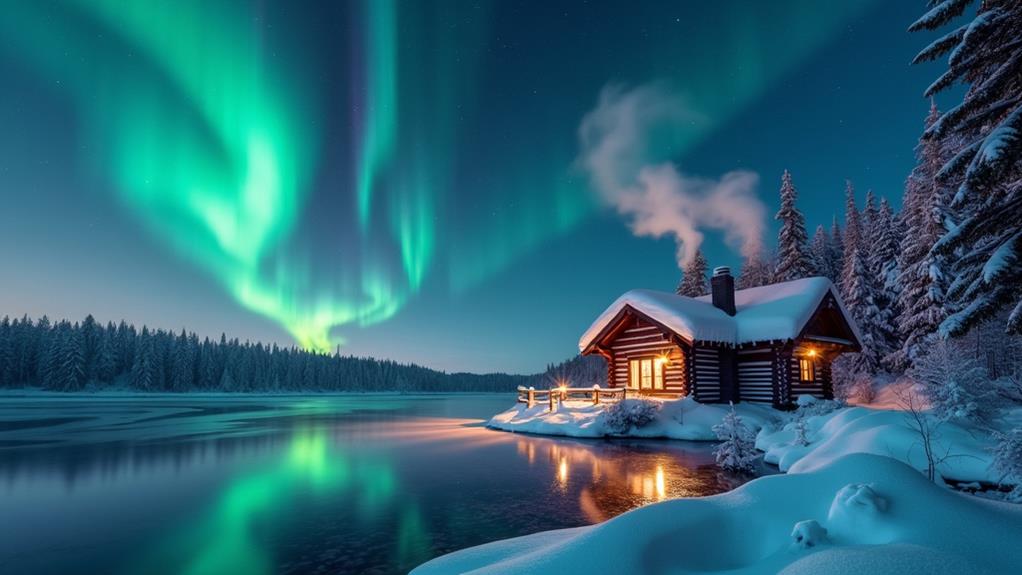
Several prime locations offer incredible opportunities to witness the Northern Lights, particularly within the Auroral Zone. Northern Norway is often considered one of the best places to see these spectacular displays. With its extended hours of darkness during the winter months, the conditions are perfect for spotting visible auroras. Tromsø, located above the Arctic Circle, provides consistent chances for sightings due to its geographic positioning.
Other top viewing spots include:
- Fairbanks, Alaska: Known for its clear skies and frequent aurora activity.
- Yellowknife, Canada: Offers a high probability of sightings and tours tailored for aurora chasers.
- Abisko National Park, Sweden: Famous for its "Blue Hole," a patch of sky that remains clear even during cloudy weather.
Seasonal Wildlife Behavior
While you're gazing at the Northern Lights, you're not alone; many Arctic animals are more active during these long winter nights. Reindeer, polar bears, and wolves take advantage of the darkness for hunting, while birds like the snowy owl migrate to find food. Some species even use the auroras as cues for their mating rituals, illustrating the deep connection between wildlife behavior and these spectacular displays.
Animals React to Auroras
The Northern Lights don't just captivate humans; they also significantly impact animal behavior. When auroras illuminate the night sky, various animals, including dogs, exhibit heightened alertness and increased vocalizations, indicating an instinctual response to the unusual light conditions. Wildlife in polar regions, such as reindeer and arctic foxes, may change their behavior during auroras, becoming more active or curious due to the bright, shifting lights.
Auroras can greatly affect the hunting and foraging patterns of nocturnal animals. The increased illumination makes them more visible to predators and alters their prey's behavior, potentially impacting survival. For migratory birds, auroral activity might act as a navigational aid during nighttime flights, helping them orient themselves in the dark.
Scientific studies have shown that auroras can influence the vocalizations of different species, suggesting a potential impact on wildlife communication during these events.
- Heightened alertness and vocalizations in animals like dogs
- Altered hunting and foraging patterns for nocturnal wildlife
- Potential navigational aid for migratory birds
Understanding these behaviors helps us appreciate the broader ecological impact of the Northern Lights.
Winter Wildlife Adaptations
Arctic wildlife exhibits extraordinary adaptations to endure the harsh winter months. In the Arctic Circle, temperatures can plummet below -30°C, necessitating unique survival strategies. Reindeer and Arctic foxes grow thicker fur and accumulate fat layers, which provide essential insulation against the extreme cold. Bears, on the other hand, adopt hibernation to conserve energy when food is scarce, essentially sleeping through the harshest parts of winter.
Migratory birds like the snowy owl travel thousands of kilometers to regions with more abundant food sources. These migrations are crucial for their survival, as they seek out small mammals and other prey in less severe environments. Seals and polar bears rely heavily on sea ice for hunting and breeding, and changes in ice patterns due to fluctuating temperatures can significantly impact their behavior and survival.
Behavioral adaptations also play a vital role. Many Arctic animals alter their feeding patterns and social structures to cope with extended darkness and extreme cold. These adaptations ensure they can find enough food and maintain social bonds, which are crucial for surviving the Arctic winter.
Cultural Significance
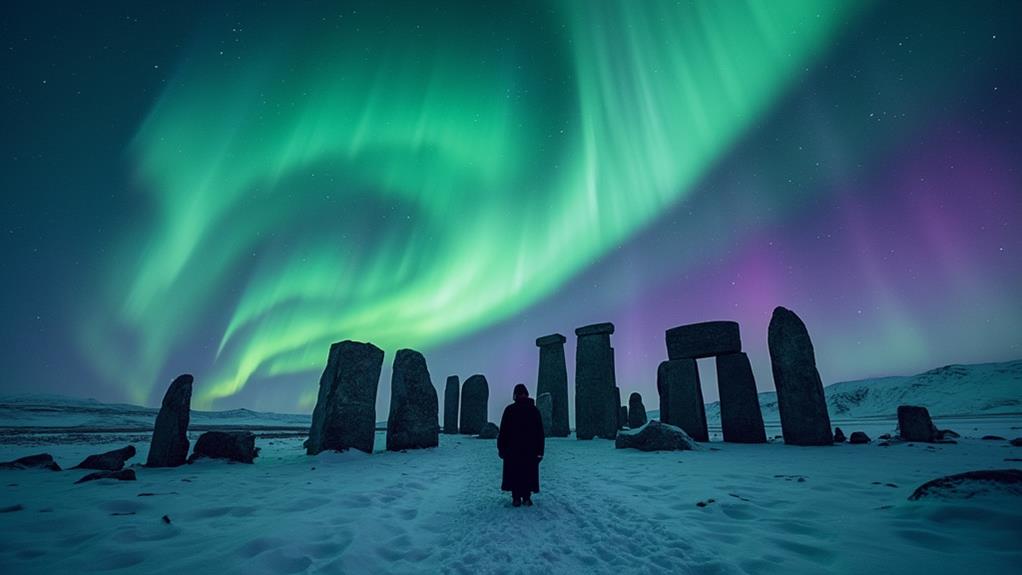
Throughout history, Indigenous peoples of the Arctic, such as the Sami, have woven the Northern Lights, or aurora borealis, into their rich tapestry of folklore and spiritual beliefs. The lights hold deep cultural significance, often seen as manifestations of ancestral spirits. The Sami, for instance, depict the Northern Lights on their shamanistic drums, symbolizing their profound connection to nature and the spiritual realm.
Diverse Arctic cultures interpret the lights in various ways. In Viking-era legends, the Northern Lights were linked to Valkyries, the warriors guiding fallen soldiers to the afterlife, reflecting their awe-inspiring role in Norse mythology. Other Arctic cultures have viewed the lights as omens or divine messages, shaping their social and religious practices.
- Sami Shamanistic Drums: The Northern Lights are depicted on these drums, highlighting their spiritual importance.
- Norse Mythology: Aurora borealis was associated with the Valkyries, showcasing its mythical significance.
- Cultural Omens: Some Arctic peoples saw the lights as messages from the gods, influencing their rituals and beliefs.
In contemporary times, the Northern Lights continue to captivate, often referred to as the "green lady," embedding them deeply in modern cultural narratives.
Travel and Accessibility
Many travelers dream of witnessing the Northern Lights, and winter offers the perfect opportunity. The best locations for viewing, such as Northern Norway and Svalbard, become highly accessible during the winter months. These areas have well-established tourism infrastructure catering specifically to aurora hunters, ensuring plenty of guided tours and services to enhance your experience.
Winter's dark, clear skies provide ideal conditions for aurora visibility. With minimal light pollution and longer nights, your chances of seeing the Northern Lights dramatically increase. Winter also offers a unique blend of adventure tourism. You can go dog sledding or snowmobiling during the day and then settle in for an evening of aurora viewing. These activities not only add excitement but also make your trip more memorable.
The peak aurora viewing season from late September to late March aligns perfectly with winter. This timing guarantees that you're traveling during the most favorable period for seeing the Northern Lights. Additionally, winter landscapes covered in snow improve accessibility to remote areas, making your travel smoother and more scenic. With all these factors combined, winter truly is the best time for an unforgettable aurora experience.

